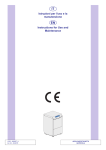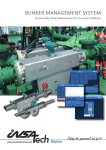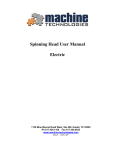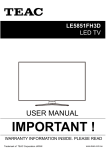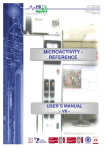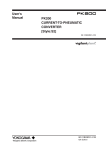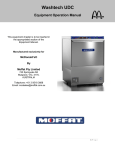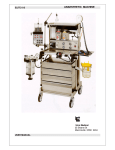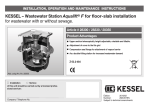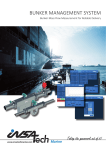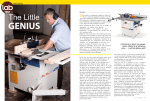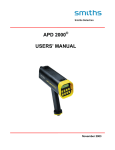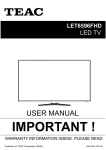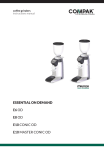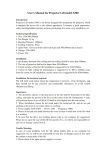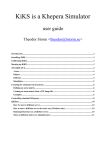Download DISHWASHER
Transcript
DISHWASHER LUX 60 EL Installation and User Manual COD.: 4400_U Ed. 02 - 03/2012 4246028, 4246029, 4246030, 4246031 Thank you for choosing our machine. The instructions for installation, maintenance and use found on the following pages have been prepared to ensure a long life and perfect operation of your unit. Please, do follow the instructions carefully. We have designed and built this machine using the latest innovative technologies. Now you shall take good care of it. Your full satisfaction is our greatest reward. TRANSLATION OF THE ORIGINAL INSTRUCTION EN CONTENTS Page WARNINGS 27 1. MACHINE DESCRIPTION 28 1.1Machine Description 28 1.2Machine features 30 2. OPERATION 31 2.1 Control panel and relative symbols 31 2.2 Machine start-up 31 2.2.1 Start-up 31 2.2.2 Operation 32 2.2.3 Switching OFF 32 2.3Detergent use 33 2.4Rinse aid use 33 2.5Drain pump system 33 2.6Regeneration function (optional) 34 2.7Additional Cooling Function (Optional) 35 WARNINGS 36 3. ECOLOGICAL ASPECTS 3.1Recommendations for optimal use of energy, water and additives 37 37 4. H.A.C.C.P. AND HYGIENE REGULATIONS 37 5. MAINTENANCE 38 5.1Routine maintenance 38 5.2Extraordinary Maintenance – by qualified Service Personnel 38 6. MACHINE INSTALLATION 6.1Handling 39 39 6.1.1 Handling the product 39 6.1.2 Storage 39 6.2Prepare for installation 39 6.2.1 Room features 39 6.2.2 Electrical connection - Characteristics 39 6.2.3 Water supply connection - Characteristics 40 6.2.4 Steam evacuation 40 6.3Installation 40 6.3.1 Positioning the machine 40 6.3.2 Electrical connection 41 6.3.3 Water connection 41 6.3.4 Start-up 41 7. SIGNALS AND ALARMS 8. ENVIRONMENTAL ASPECTS 42 43 8.1Packaging 43 8.2Disposal 43 9. TROUBLESHOOTING 44 READ THESE INSTRUCTIONS CAREFULLY BEFORE INSTALLING THE MACHINE. WARNING: FAILURE TO COMPLY, EVEN PARTIALLY, WITH THE PRESCRIPTIONS IN THIS MANUAL WILL RENDER THE PRODUCT WARRANTY NULL, AND THE MANUFACTURER SHALL NOT BE LIABLE. page 25 EN WARNINGS This instruction booklet must be kept with the machine for future consultation. If this machine is sold or transferred to other users, make sure the booklet always goes with the unit so that the new owner can have all the necessary information on operations and all relevant instructions. The instruction booklet must be carefully read before installation and before starting the machine. These instructions are supplied to safeguard the users in compliance with Directive 2006/95/ CE as amended and the “harmonized product Technical Standard” EN 60335-1 and EN 60335-2-58. • THE CONNECTION TO THE ELECTRICAL AND WATER NETWORKS, FOR INSTALLING THIS UNIT, MUST BE CARRIED OUT BY QUALIFIED OPERATORS ONLY. • The user shall not carry out any repair and/or maintenance operations. In any case contact qualified personnel. • Only qualified personnel can access the control panel, when the main power switch is OFF. • Servicing of this machine must be performed by authorized personnel only. N.B.: Use genuine spare parts only. Non-genuine parts will void the warranty and the manufacturer will take no responsibility for any damage. • Follow the instructions given in the manufacturer’s booklet for cleaning operations (chap.5). • This machine must only be used by adults. This is a professional machine to be used by qualified personnel, installed and repaired exclusively by qualified Technical Personnel. The Manufacturer declines any responsibility for improper installation, use, maintenance or repair. • The appliance shall not be used by children or persons with reduced physical, sensory or mental capabilities, or lack of experience and knowledge. • Children must be attended and shall stay away from this machine. NOTE: The manufacturer declines any responsibility for accidents to people or any damage deriving from failure to observe the above listed instructions. page 27 EN 1. MACHINE DESCRIPTION 1.1 Machine Description Control panel 1 2 Wall-hung main power switch: at installation serviceman supply and care, according to local laws 3 Door Control panel Control panel 1 2 3 Door 1 2 3 Door Standard equipment for machine with a 50mm rack: nr. 1 glasses rack and nr. 1 plates rack 500x500mm Capacity per plate rack: 12 soup plates or 18 flat plates Max Ø = 400 mm and nr. 1 cutlery basket page 28 EN Option D) Other standard equipment for machine with a 50mm rack: C) nr. 1 square trays rack 500x500mm or D) nr. 1 trays support 6 pcs and nr. 1 inox spatulas rack Option C) Standardequipmentformachinewitha 40mm rack: option A) nr. 2 square glasses racks 400x400mm or option B)nr.2roundracksØ400mm nr. 1 support for round rack Option B) Standardequipmentformachinewith a 40mm rack: nr. 1 cutlery basket and nr. 1 saucers holder Option A) Optional: Drain pump Optional: Water softener Optional: Detergent dispenser Optional: Probe lack detergent/rinse aid page 29 EN To operate the machine, 3 connections are needed: • Electrical; • Water supply; • Water drain. This is a cycle machine comprising a 55°C wash cycle with detergent, a 82°C rinse cycle with injection of rinse-aid in the boiler hull. This machine is designed exclusively for washing dishes, glasses and various pots and pans with human food type of residue. Any other use is deemed improper. DO NOT wash articles polluted with petrol, paint, chips of steel or iron, fragile objects or material not resistant to the washing process. Do not use acidic corrosive chemical products or alkaline and solvents or chlorine based detergents. Do not open the machine door when operating. In any case, the machine has a special safety device which immediately stops the unit if the door is open, thus preventing water spillage. Always switch the machine completely off and drain the water tank, before accessing inside. The drain pump optional is used to keep the correct water level in the wash tank. To drain completely the wash tank at the end of the day, see chap. 2.5 "Drain pump system". 1.2 Machine features The machine has a noise level below 65 dB(A). Total power Power supply Total absorption Pump power 1 2 3 Electrical protection rate Protection rate page 30 EN 2. OPERATION 2.1 Control panel and relative symbols A B C D E F G 1 2 3 H pict. 1 1 2 3 1 2 3 I J K L A) Cycle light indicator B) Selectedcycleindicator C) Tank temperatur display D) Boilertemperaturedisplay E) ON/OFFindicator F) Regenerationindicator G) Drain indicator H) STARTpush-buttontostartupcycle/selectcycle I) Cool extra indicator J) Switching–On/STANDBYbutton K) Regenerationpush-button(optional) L) Drainpush-button(optional) 2.2 Machine start-up 2.2.1 Start-up • 1 2 3 • • Inserttheoverflowpipeinthespecialseatinsidethetank.Makesureallthefiltersare properlyfittedintheirseats(seepict.2).Thefiltersmustbecleanedevery30-40wash cycles and whenever necessary. Do not operate the machine without filters and in particular the pump suction filters. Closethedoor. Turnthewatervalve“open”. Turn the main power switch ON. Turn the button "J"(seepict.1). The machine start will be active when the "E"indicatorwilllightgreen.Afterafewseconds thetankfillingphasestarts. 1 2 3 1 2 3 pict. 2 • • Afterfilling,themachineautomaticallystartstheheatingphase. Themachinewillbereadyforwashingonlywhentheboilerandtankthermometers"C" and "D" indicate that the required temperatures have been reached, which are 80-85°C for boiler and 50-55°C for the tank. • Insertthespecialgreenrinseaiddispensertubeintheliquidrinseaidcontainerand checkthatthequantityissufficientforthedailyrequirement.Thetransparenttube(if present)mustbeinsertedinthedetergentcontainer. page 31 EN 2.2.2 Operation • • Insert the rack filled with dishes to wash. The plates must be correctly placed in the rack (see pict. 3). Close the door. Select the wanted washing cycle (1, 2, 3, ∞) by pushing the button "H" (see pict. 1). The display will show in sequence all available programs. Once the wanted program is displayed, do release the button. The green LED "B" of the selected cycle lights up (1, 2, 3, ∞). 1 2 pict. 3 3 • Start the cycle by pushing the button "H" for not more than 1sec (see pict. 1). Starting of the cycle is signalled by the indicator of the selected cycle flashing. At the end of the cycle the indicator stops flashing and the message "END" appears on the display. • The machine is ready for a new wash. It is advisable to change the tank water, by means of another filling, at least every 40-50 washes or twice a day. N.B.: the machine does not accept other cycles until the door is opened or the button "H" is pressed twice (see pict. 1). The cycles (1, 2, 3, ∞) are factory-set with times of 60 - 120 - 180 - 300 seconds. 2.2.3 Switching OFF • Turn the button "J". The machine will turn in "STAND-BY" mode (the red LED "E" comes ON). • Drain completely the wash-tank. Take off the overflow pipe. For machines equipped with drain pump see chap. 2.5. Switch the main power switch OFF. Shut the water valve. At the end of the day, clean the machine (see chap. 5 "Maintenance"). • • • page 32 EN 2.3 T EN G ER T DE 2.4 D RI E NS AI Detergent use ThedetergentshallbetheNOFOAMtype,suitableforindustrialdishwashers,andmust complywiththeEN60335-2-58/A11norms. The use of good quality liquid detergents is recommended. The detergent must be introduced in the tank. The amount is recommended by the manufacturers according to the water hardness. Byrequestthedishwashercanbeequippedwithanelectricdetergentdispenser(always recommended). 1cm.oftheproductdrawnintothetubeisequaltoabout0.15g.Acorrectamountofdetergent is very important for a successful wash. Shouldthedetergentlack,thedisplaywillshow"NO DE" (onlywithoptional"Sensorfor ChemicalsLowLevel"). Rinse aid use The machine has a standard rinse aid dispenser. The machine automatically sucks the product. The rinse-aid chemical, shall be suitable for professional glass and dishwashers and must complywiththeEN60335-2-58/A11norms. The recommended amount is 2-5 cm of product measured on the suction hose. The quantity can be regulated with the micrometric dispenser screw. The amount is decreased with clockwise rotation and increased with counter-clockwise rotation. 1cmoftheproductdrawnintothehoseisequaltoabout0.13g.Acorrectamountofrinse aid is very important for a quick and proper drying. N.B.:Excessiveamountofchemicalsorfoamwillreducewashpumpefficiency. Shouldthedetergentlack,thedisplaywillshow"NO RI" (onlywithoptional"Sensorfor ChemicalsLowLevel"). 2.5 Drain pump system The cycle drain pump works in an automatic and independent way. Attheendoftheday,tocompletelyemptythetank: Press the button "J". The machine will turn in "STAND-BY"mode(LEDrossoacceso). Removetheoverflow. Close the door. Press the button "L";thegreentankdrainindicatorcomesONfortheprogrammed set time. Afteremptyingthemachinewillturnin"STAND-BY" mode. Ifaalarmappears,seechap.7. N.B.: The machine must not be switched ON during the emptying phase. IMPORTANT: Always turn the main wall switch off and close the water cock at the end of use. page 33 EN 2.6 Regeneration function (optional) Regenerationiscarriedoutaftertheflashingsignaloftheregenerationkeyindicator"F". SALT IMPORTANT: Before starting a regeneration cycle check if there is salt in the special container (max 0,500kg). Fillthespecialsaltcontainerwithtankemptyandmachineoff. When displaying "NO SA"(alternatedtothetankandboilertemperaturesandwithmachineonstand-bymode)addsaltinthecontainerinthewash-tank(onlywithoptionalwater softener). Rinsethetankimmediatelyifsaltisspilledinit. To start the regeneration cycle, switch the machine off with the key "J". TheredLEDlightsup. Emptythetank.Removetheoverflow. 1 2 3 Formachinesequippedwithdrainpumpseechap.2.5. Press the "K"button;thedisplaywillshow"rege". TheregenerationLEDlightsupandthemachinecarriesoutwiththevariousphases. Thecycleisfinishedwhentheindicator"F" goes off, after around 20 minutes. Note:Regenerationtimeswillbeblockedonlyifthedoorisopened. The optional regeneration is not allowed in the following conditions: • duringprogramming. • duringthewashcycle. • duringmanualdraining. • ifthedoorisopen;inthiscasethemessage"DOOR" will be displayed for about 4sec. • page 34 ifthemachineisON. EN 2.7 Additional Cooling Function (Optional) This function can only be enabled if the machine is installed with the optional "Additional Cooling" function. Machine ON. Press the button "K" for at least 3 sec. After the hot rinse is completed, an additional fresh-water rinse can be made. During the wash cycle or manual draining the type of rinse selected cannot be changed. The Additional Cooling selection is displayed with the decimal point of the second display lighting up. Note: The Additional Cooling selection is not memorised and must be set every time the machine is switched off and then on again (if this function is required). page 35 EN WARNINGS: • • • Do not slam the door when opening and closing. Do not put material or objects on the machine. The machine has an IPX3 protection rating against accidental water splashes and is not protected against pressurized water jets. Pressure-cleaning systems shall, therefore, not be used on this machine. • Do not dip bare hands into water containing detergent. If this should occur, wash them immediately with plenty of water. Check the safety instructions on the detergent container. • Some important rules must be followed for using this appliance: 1) never touch the appliance with wet hands or feet; 2) never use the appliance when barefooted; 3) do not install the appliance in places exposed to water splashes. • This machine must be disconnected from the main electrical supply after use at the end of the day and for any service/maintenance operation. Switch off the main switch located on the wall, which shall be installed by a professional installer. Shut the water supply valve(s). • Do not cover the intake or dissipation grids. • Do not use water to extinguish fires on electrical parts. WARNING: INTERNAL CLEANING OF THE MACHINE SHALL BE CARRIED OUT AT LEAST 10 MINUTES AFTER THE POWER SWITCH HAS BEEN TURNED OFF. WARNING: DO NOT INSERT HANDS AND/OR TOUCH THE PARTS LOCATED AT THE BOTTOM OF THE WASH TANK AND/OR AT THE END OF THE WASH CYCLE. page 36 EN 3. ECOLOGICAL ASPECTS 3.1 Recommendations for optimal use of energy, water and additives Saltdosing Apre-set(bythemanufacturer)quantityofsaltisinjectedintheresinsateachregeneration cycle.Itisimportanttoobservethenumberofregenerationcyclesrecommendedinparagraph2.6"Regenerationdevice"inordertoavoidsaltspillsorlimedeposits. Use the machine fully loaded when possible. This shall prevent detergent, rinse aid, water and energy consumption waste. Detergent and rinse-aids Use detergents and rinse-aid chemicals with high biodegradability, to best respect the environment. Verify proper dosage in relation to water hardness at least three times a year. Excessproductpollutesriversandseaswhileaninsufficientdoseresultsinunsatisfactory dish washing and/or hygiene. BoilerandWash-Tanktemperatures The boiler and tank temperatures are set by the manufacturer in order to obtain the best washing results with detergents on the market. The temperatures can be reset by the installer in relation to your detergent. Pre-washing Carefully pre-wash with a moderate amount of water at room temperature to facilitate the removal of animal fats. To remove encrusted materials warm water soaking is recommended. Note: Wash objects as soon as possible to avoid deposits from drying and compromise effective washing. Foreffectivewashingroutinedishwashercleaningandmaintenanceisadvised(seechap.5). Disregarding the points listed above and of any the information contained in this manual can cause energy, water and detergent waste with a subsequent increase in running costs and/or performance reduction. 4. H.A.C.C.P. AND HYGIENE REGULATIONS • • • • • • • WhenstartingthemachineON,nowash-cyclewillbestartinguntilthesetboilerand wash-tank temperatures are reached. During operation, the machine will not start the rinse cycle till the set boiler temperature is reached. Removecarefullyallsolidsfromtheobjectstobewashed,toavoidobstructionoffilters, nozzlesandpiping. Drainthewashtankandcleanthefiltersatleasttwiceaday. Check if the detergent and rinse-aid dosage are correct (as recommended by the manufacturer).Inthemorning,beforestartingthemachine,checkthatthequantityof chemicals in the canisters is enough for daily supply. Keepyourworkingtablesclean. Extracttherackwithcleanhandsorglovestoavoidfingermarks. Do not dry or polish the washed objects with cloths, brushes or rags that are not sterile. page 37 EN 5. MAINTENANCE 5.1 Routine maintenance WARNING: The machine is not protected against pressurized water jets. Do not use pressure cleaning system against the machine. It is recommended to contact the seller of chemicals for proper cleaning instructions, in order to have detailed indications on methods and products for the correct periodical machine sanitation. Do not use bleach or chlorine based detergents. Daily cleaning is needed to ensure that the machine runs perfectly. The following shall be carried out: • Turnthemachinein"STAND-BY" mode, by pressing the push-button "J" of the control panel(seechap.2). 1 2 3 • • • 1 2 3 Removethesurfacefiltersandcleanthemunderrunningwater(seepictures4).Drain thesumpwater(seechap.2.2.3). Removethepumpfilterandcleanwithabrushandawatershower. Removethearmsbylooseningthefixingscrews,andthoroughlycleanthem,andthe nozzlesunderrunningwater. 1 2 3 1 2 3 1 2 3 • Reassemblethepartsandrepositionthewashpipesfirmlyinplace. • Cleanthetankverycarefully,usingawatershower. • Itisrecommendedtoleavethemachinedooropenattheendoftheday. • Shutthewatervalve. • TurnedoffthemachinebyswitchingthemainpowerswitchOFF. Automatic cycle of machine self-cleaning/rinsing: recommended at each day end. • Themachineshouldbein"STAND-BY"mode(withoutfilter,withoutoverflowpipeand machinedoorclosed).PushSTARTbutton"H";anautomaticcycle of 60 seconds will start, after this the machine will be in "STAND-BY" mode. • Shutthewatervalve. • TurnedoffthemachinebyswitchingthemainpowerswitchOFF. 5.2Extraordinary Maintenance – by qualified Service Personnel Onceortwiceayearhavethemachineinspectedbyaqualifiedtechnician,inorderto: 1 Cleanthesolenoid-valve(s)filters; 2 Removescalefromtheheatingelements; 3 Controlthestatusoftheseals; 4 Controlforcomponentsintegrityand/orconsumption; 5 Controlthedispenser(s)efficiency. Aqualifiedelectrician,shouldcheckallelectricconnectionsinsidethemachine,atleast once a year. pict. 4 page 38 EN 6. MACHINE INSTALLATION 6.1 Handling 6.1.1 Handling the product The machines must be handled strictly as shown in pict. 5 regarding the grip points indicated for lifting with a lift truck. Latch the machine in a way that secures no vibration or shocks during transportation. N.B.: Slinging with ropes not recommended. After unpacking, make sure the appliance has not been damaged due to transportation. If it has been, do notify the seller about this problem. If the damage might question the machine’s safety, do not install the appliance. See chapter 8 for disposal of the packing material. pict. 5 6.1.2 Storage Storage temperature: min. +4°C - max +50°C - humidity <90%. The stored parts should be checked periodically, to detect any sign of deterioration. Do not put anything on the machine, even if packed in its box. 6.2 Prepare for installation This is just a guide-line for the machine installation. The installation must be performed by a qualified engineer. 6.2.1 Room features Install the machine, in a room closed to weather and with a guaranteed temperature-range between 5 and 35°C. The machine is equipped with thermostatic sensors to manage the temperatures. To guarantee a proper functionality these sensor shall not operate at a room temperature below 5°C. For this reason, it is fundamental that before starting the machine reaches the room temperature. 6.2.2 Electrical connection - Characteristics The electrical connection to network shall be carried out in accordance to the local laws in force. Make sure that the supply voltage is the same as reported on the machine plate and that the network can stand the needed power absorption shown on the same plate. Make sure that the facility is equipped with efficient ground connection. page 39 EN A suitable omni-polar, one-way switch shall be installed and sized according to the absorption provided, with a contact opening of at least 3 mm. This switch shall be solely and exclusively used for this purpose and installed in the immediate vicinity of the machine, installed in full respect of the local laws. Always turn the machine off via this switch. This is the only model of switch that guarantees a total electrical power disconnection. 6.2.3 Water supply connection - Characteristics Fresh water supply features: Table 1 Water characteristics table Static Pressure Dynamic Pressure Water hardness* Cold water-supply temperature Hot water-supply temperature** Capacity Min 250Kpa 200Kpa 2°f 5°C 50°C Max 400Kpa 350Kpa 8°f 35°C 60°C 12lt/min Connect the machine's water supply with an interrupt valve capable of quickly and completely shutting off water intake. *It is compulsory to install a water-softener, in case of water with average hardness above 8°f. Washed objects will be cleaner and the machine will last much longer. The machine can be equipped with a water softener, on request. If the machine is equipped with a water-softener, a regeneration of the resins shall be done on regular basis (see par. 2.6). N.B.: Any damage caused by limestone (calcareous water higher-up than 8°F and without water-softener) will not be covered by warranty. A periodical check of the supplied water hardness is highly recommended. **The water supply temperature shall never exceed 55°C. 6.2.4 Steam evacuation In accordance with regulations of environmental hygiene, for the proper functioning of the machine and a healthy environment for the operator who working in there, it should be at least 10 air volume changes per hour in the room where the machine is installed. For small wash rooms we recommend at least 15 air volume changes per hour 6.3 Installation 6.3.1 Positioning the machine Remove the packing with care. Lift the machine as described in chap. 6.1.1 " Handling the product". Position the machine as shown on the installation diagram (lay-out) approved at the time of the offer. Maintain a minimum distance of about 50 mm from the walls, so that motors are ventilated. Install suction hoods to assure proper ventilation of the room, in order to eliminate steam and excessive humidity. Check that the machine is properly levelled, by adjusting the legs. Make sure the machine is not standing on the power cable or on the filling/drain hoses. Level the machine flat, by adjusting the support feet. page 40 EN 6.3.2 Electrical connection The electrical connection shall be carried out in accordance to the local laws in force. , that is meant to The machine has a connection at the back, indicated by the symbol link the steel structure and masses among different apparatuses, to prevent electro-static electrical shocks. The electrical supply cable must be new, flexible, and according to "har" H07RN-F or a local valid equivalent. The cable size is dimensioned according to the power. Should the electrical supply cable get damaged it shall be changed by the Manufacturer, or his Authorized Service, or other technician with equivalent qualification, to prevent any risk. If the machine is fitted with a three-phase pump, check the correct motor rotation (right rotation as per arrow on the casing). This is not needed if the pump is a single-phase model (standard). 1 2 3 6.3.3 Water connection MAX 0,5m pict. 6 pict. 7 Connect the water in-feed hose, given with the machine, to a ¾” water supply tap. Connect the machine draining pipe to the connection located at rear, under the back-panel, in such a way that water flows freely (therefore ensuring a minimum slope). If the water cannot be discharged to a level below the machine drain, it is advisable to install a drain pump (supplied on request). Maximum drain height = cm. 50 (see pict. 7). The drain tube shall always be connected to a siphon in order to prevent the release of odors. In those machines equipped with “water softener” the water supply temperature shall not exceed 40°C, to avoid damages to the filters’ resins. 6.3.4 Start-up At installation engineer’s care. page 41 EN 7. SIGNALS AND ALARMS The alarms and the signals messages are visualized, based upon their meaning . When on the display the LED "F" above the "K" key flashes, a total regeneration is needed (only with optional water softener). When flashing "NO DE" (alternated to the tank and boiler temperatures and with machine on stand-by mode), add detergent in the detergent tank (only with optional "Sensor for Chemicals Low Level"). When flashing "NO RI" (alternated to the tank and boiler temperatures and with machine on stand-by mode) add rinse-aid chemical in the rinse-aid tank (only with optional "Sensor for Chemicals Low Level"). When displaying "NO SA" (alternated to the tank and boiler temperatures and with machine on stand-by mode) add salt in the container in the wash-tank (only with optional water softener). When displaying "DOOR" means that the open door does not allow the maneuver tried, or a wash cycle was in progress, when lifting the door. TYPE OF ALARM B1 CAUSE BOILER FILLING FAIL B2 B3 B4 B5 E1 BOILER PROBE FAIL. BOILER HEAT. ALARM RINSING FAILED TIME OUT RINSE BOILER OVERHEATING WATER LOAD FAILED E2 E3 E5 E6 Z6 TANK PROBE FAIL. TANK HEATING ALARM TANK OVERHEATING TANK DRAINING FAIL. TANK LOW LEVEL Z9 Z10 REGENERATION FAIL ALARM SL8 - BREAK TANK HIGH LEVEL Table 3 page 42 REMEDIES Open the water supply valve and verify a proper water supply flow. Contact Technical Service Contact Technical Service Contact Technical Service Contact Technical Service Contact Technical Service Open the water supply valve. Contact Technical Service Contact Technical Service Contact Technical Service Contact Technical Service Check the overflow pipe. Contact Technical Service Drain and load the tank. Contact Technical Service Contact Technical Service Contact Technical Service EN 8. ENVIRONMENTAL ASPECTS 8.1 Packaging Packaging is made of the following components: • a wooden pallet; • a nylon sack (LDPE); • a multi-layer carton; • polystyrene (PS) strips; • polypropylene (PP) banding. All above materials, shall be disposed and treated in accordance with the Local Laws in force. 8.2 Disposal The symbol WEEE/RAEE used on this product indicates that it cannot be treated as domestic waste. Proper disposal of this product contributes to protecting the environment. For more information on product recycling, contact the local authorities, domestic waste authorities or the dealer where the product was purchased. For product or parts disposal, follow the Council directives 2002/95/EC and 2002/96/EC as amended and/or application legislative decrees. The present product or parts cannot be disposed of as urban waste but shall be collected in separate containers (see the waste bin on wheels symbol with an “X” on the product). At the time of product disposal, the user shall refer to the waste electrical and electronic equipment (WEEE/RAEE) specification. The manufacturer guarantees the absence of dangerous substances in the EEA used in conformity to the directive 2002/95/EC. If the user does not comply with the regulations he/she shall be subject to the penalties foreseen by each member state. Disconnect electricity and water before disposal. Cut away the electrical cable to ensure that further use is impossible. All metal parts are recyclable as they are made of stainless steel. Recyclable plastic parts are marked with the plastic material symbol. page 43 EN 9. TROUBLESHOOTING Type of Problem The machine does not turn on The machine does not load water. Possible Causes Main switch not ON. Water valve shut. Rinse area nozzles or solenoid-valve filter blocked and/or scaled with limestone. Defective pressure-switch. The water drains very slowly Scarce water supply pressure from the machine Rinse booster pump blocked (if installed) START button "A" flashing See chapter 7 "Alarms". (red colour) Washing results are The washing nozzles are obstructed unsatisfactory. or the rack does not rotate. Foam is present. Glasses or dishes are not properly dried. Streaks and spots on glasses and dishes. The machine suddenly stops during operation. The machine stops during the wash stage and starts refilling water. Cure Turn switch ON. Open the hot and/or cold water valve. Clean the rinse arm nozzles, piping and solenoid-valve filter. Check that the water hardness is <10°f. Replace pressure-switch. Check the water supply pressure Call for Service --- Clean the nozzles carefully, and check the right positioning of the wash-arm, tightening firmly. Use no-foam detergents or reduce the dose in use. Check the rinse-aid dosage. Fats or starches not removed. Insufficient detergent concentration. Filters are dirty. Remove filters, clean with brush under a jet of water and replace in original position. Check tank temperature (which must Adjust the thermostat or check correct heating element operabe between 50°C and 60°C). tion. Wash time insufficient for the type of Select a longer wash-cycle, if possible, otherwise repeat the dirt. wash cycle. Wash water is dirty. Drain the tank water, clean the filters; refill the tank and replace the filters correctly. Not enough rinse aid. Increase dosage by turning the dispenser screw (call for Service). The rack is not suitable for the pots or Use the suitable rack which gives the pots and tools an inclined the tools. position so that water can rinse away. The washed items may have been As soon as the cycle stops, remove the rack with pots and tools sitting in the wash chamber too long. so that they can dry more quickly in the air. Rinse temperature under 80°C. Check the boiler thermostat temperature. Surface of dishes and glasses too Replace type of dishes and glasses used. If the dirt on the rough or porous for material wear. dishes is dry and old, soak before washing. Too much rinse-aid chemical. Reduce the rinse aid amount by turning the micrometric dispenser screw (see par. 1.4 "Rinse aid dispenser"). Too hard water. Check the water quality. Water must not exceed 8°f in hardness. For appliances with softener: too little Fill the salt container (coarse salt: 1-2 mm grains) and regenesalt in the salt container or the resins rate the resins more often. If lime deposits are also observed on have not been properly regenerated. the body of the machine, have a qualified technician check the operation of the water softener. Salt present in dishwasher sump. Thoroughly clean and rinse the appliance, and avoid spilling salt when filling the container. The machine is connected to an Connect the machine on a own overload device (call for overload device. Service). A machine safety device was Check the electrical devices (call for Service). triggered. The previous day's water was not Drain the tank totally and refill. changed. Excessive water temperature in tank. Call for Service to check thermostat and pressure-switch. Defective pressure switch. N.B.: For any other question, please contact your Service provider. The manufacturer has right to modify any technical characteristics without prior notice. page 44

























